A dry bag is one of those things you never realized you needed, but once you have one, you have no idea how you lived without it. From taking it on a cruise, to the beach, to the pool, river, or lake, there are tons of times where having a dry bag comes in handy.
If you aren’t familiar, these bags are made of heavy-duty vinyl material that’s waterproof. You simply toss in anything you don’t want to get wet, roll down the top of the bag and buckle it closed. You now have a pouch designed to stay dry, even if you get caught in the rain or fall in the water.
But that doesn’t mean every bag is created the same. We recently bought and tested three different dry bags. After testing their strength, features, and waterproof ability, only one came out the undisputed winner.
The Three Bags Tested
For our test, we purchased three different bags from Amazon. All three made similar claims as to their ability. For our purposes, we tested the 10 liter sizes of the bags. Here are the three in our test:
- Såk Gear Premium Waterproof Dry Bag ($21)
- Ultra Dry Adventurer Premium Waterproof Bag ($20)
- Freegrace Waterproof Dry Bag ($19)
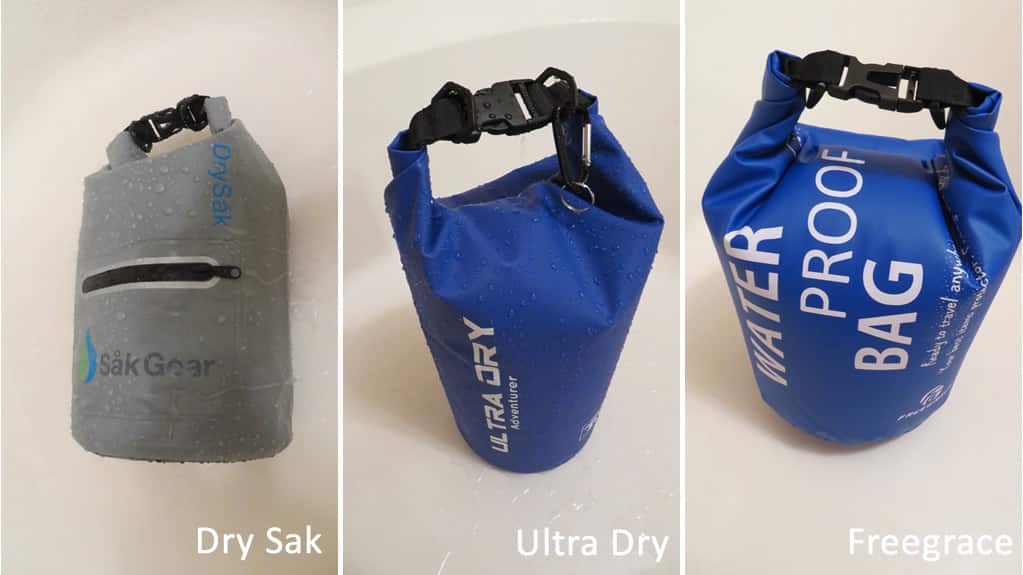
Why test these three bags?
We were interested in the Sak Gear bag due to its exterior pocket. The one issue with dry bags is when closed, your items aren’t easily accessible. You have to unroll and open the entire bag back up. Having an exterior dry pocket seemed handy.
We liked the Ultra Dry Adventurer thanks to the fact that it included a waterproof phone case with the bag.
Finally, we were interested in the Freegrace bag because it offers an inner seal as another layer of protection to keep water out.
After ordering the bags, it took only a couple of days for them to arrive thanks to being members of Amazon Prime. (If you’re not a member, you can register for a 30-day trial.)
First Impressions of the Dry Bags
Opening up all three of the bags, we were first struck at how similar all of them were. Each bag felt like it was made of the exact same material, with the same thickness.
The bags themselves are a vinyl-like material. It feels thick — as if it would stand up to a beating and wouldn’t be easily punctured. Still, all of the bags are still pliable.
Since we ordered 10-liter bags, all three were the exact same dimensions. Laying flat, the bags measure 12 inches across. Standing up, they stand about 19 inches tall.
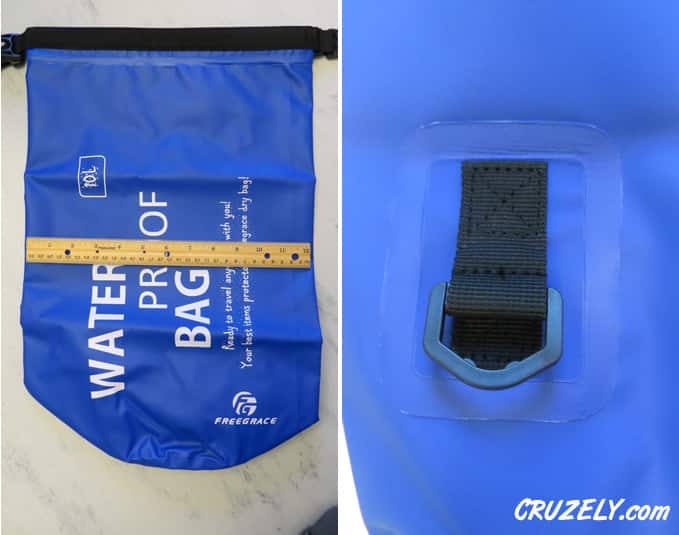
Build quality appeared to us to be the exact same. Seams are sealed tight and nowhere on any bag do they seem thin or poorly sealed. The attachment point for the carrying strap is sealed extremely well on all three bags.
Our first impression of each bag is that they would hold up well to abuse and keep things dry for years. They are all made of heavy-duty material and seem well made.
The only drawback we saw was that the plastic hooks and loops on the carrying strap and the attachment points were areas that could fail over time. The hooks are made of cheap plastic. While they are sufficient for occasional use, if you carried one of these bags by the strap while carrying a full bag, we think they would break over time.
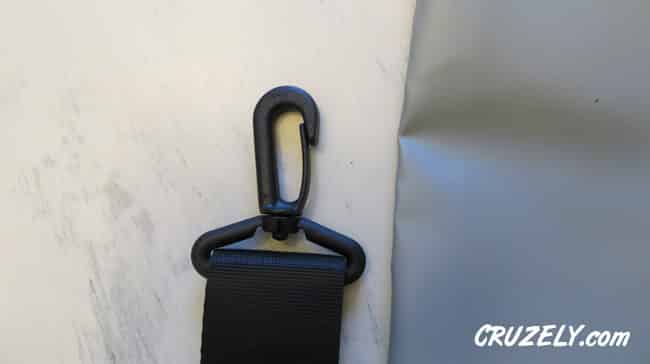
We selected a 10-liter sized bag because we wanted something to fit in a few items without the bulk of carrying a large bag with us. Fully open, the base of each bag measured a little over six inches in diameter.
For reference, we were able to fit seven cans and bottles into the base of each bag. When rolled up and sealed, the bag is about the size of a volleyball. It’s enough room for items like keys, phones, and wallets. You wouldn’t be able to fit a towel and a change of clothes in this size bag. You’d want a larger size.

When it comes to specific features on each bag, there were some differences.
The zippered outside pouch on the Såk Gear bag was big enough to fit a large cellphone in. The pouch also appeared well sealed to the bag, and the zipper looked like it would seal well.
The Freegrace Waterproof Dry Bag’s inner seal was also unique. It is a dual-layer seal, similar to what you would see in a Ziploc bag. The seal is bonded to the inside of the bag, so that water can’t get behind it.
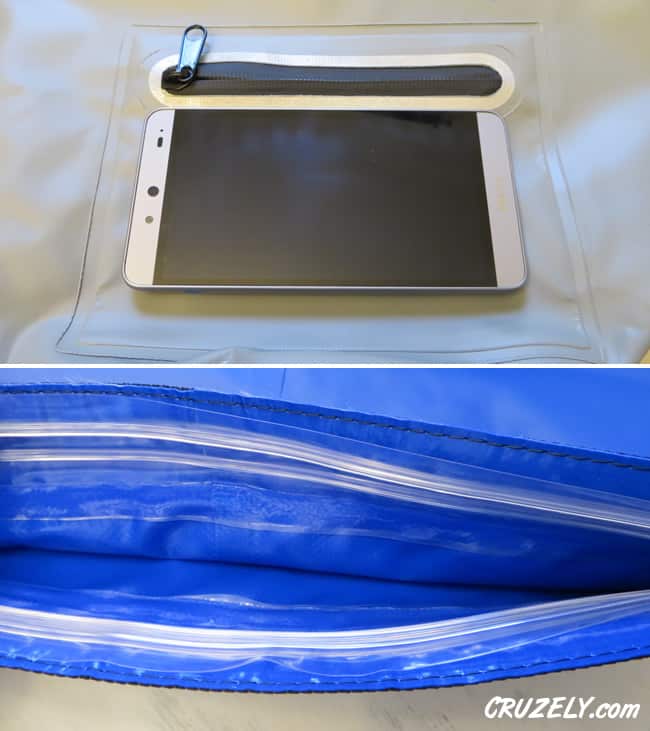
Overall, we were impressed with the quality of each bag, especially given that each one costs only $20.
The 20-Pound Weight Test
After being satisfied with the initial quality of each bag, we wanted to put all three to the test. The first thing we did to test each bag with a 20-pound kettlebell. We simply placed the weight inside the bag, sealed it up, and then raised and dropped the bag several times.
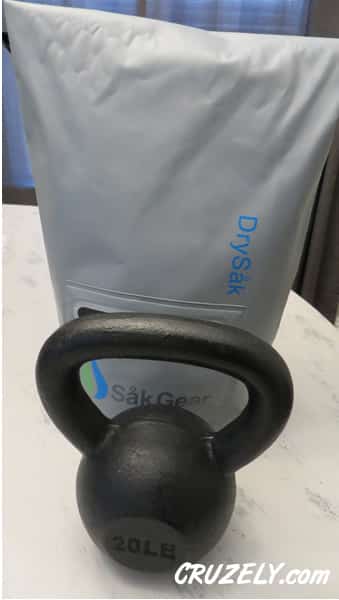
The kettlebell fits nicely in the base of the bag and puts a large amount of weight into a small area. We think this represents an extreme case of what most people would use one of these dry bags for. Still, if it could hold up to this then we knew it would hold up to most anything you can throw at it.
We tested each bag in the same fashion.
After the test, each bag held up extremely well. We inspected the base of each and found no tears, rips, or seams coming apart. The handle also help up well. Frankly, during the test all the bags felt like the weight was no big deal. We’d have no problem carrying 20 pounds or more in one of these bags.
The Shower Test
Now that we knew each bag could stand up to being weighted down and tossed around, we wanted to test the most important part of any dry-bag — if it’s actually waterproof.
For each bag, we first stuffed them with dry paper towels to have evidence in case the bags leaked. We then sealed them according to the included instructions. For the Såk Gear
Ultra Dry bags, this included rolling down the top of the bag 3-4 times and then clipping the latch shut. For the Freegrace bag, we first closed the inner seal before rolling the top down and closing the latch.
We then placed the bags individually in a shower for approximately one minute to simulate being caught in a heavy downpour. During the test we also moved the bag all around to allow water to hit from every angle. If a bag was going to be waterproof, we wanted to make sure conditions didn’t have to be perfect for the contents to stay dry.
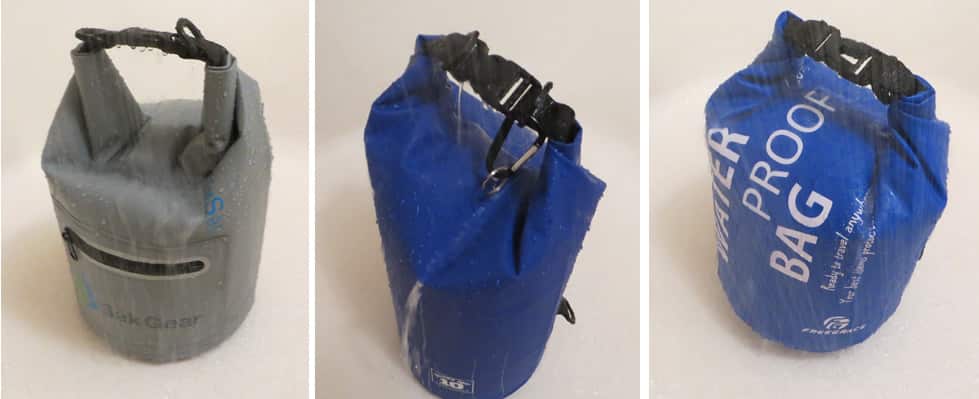
Såk Gear Premium Waterproof Dry Bag
Our first test was the Såk Gear Dry Bag with the exterior pocket. We should note that the manufacturer says this pocket is for “light rain or splashes only.” In our test, we had a direct shower on all parts of the bag.
Opening up the exterior pocket, the paper towels we put inside were completely soaked. Given the manufacturer warning, we weren’t surprised by this. Still, we wanted to see how the pocket performed in extreme conditions.
What we were surprised by, however, was the inside of the main compartment. After the shower test, we unrolled the top of the bag. Water had actually collected inside of each roll. As well, the canvas strap at the top of the bag was soaked.
Looking inside, it seemed as if water had wicked from this canvas strap to inside the bag. While the paper towels at the bottom of the bag were still dry, there were drops of water making their way inside the bag.
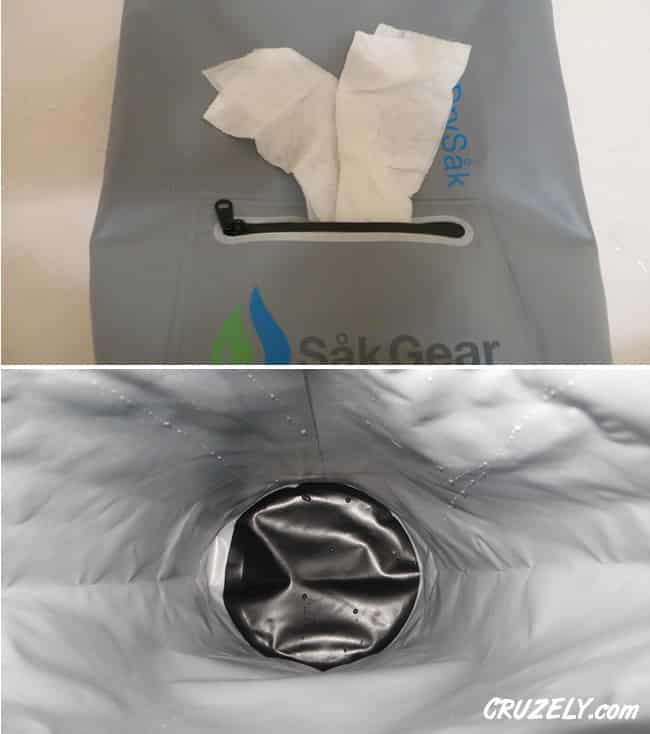
Considering that we would put items like cellphones in this bag to keep dry, any water inside was bad news.
Ultra Dry Adventurer Premium Waterproof Bag
The next bag test was the Ultra Dry Adventurer. With no exterior pocket, there was only the main compartment to test.
Again, we placed a wad of dry paper towels into the base of the bag and followed instructions to seal up the dry bag. After our one-minute shower test, we opened the bag back up.
Just like with the Såk Gear bag, water collected in the rolled top, soaking the strap at the top of the bag. It seems as if that water wicked its way to the inside of the bag. We saw trails of water running down the inside of the bag and also had some spots on our paper towels.

Remember, while we were subjecting these bags to a heavy soaking, we weren’t submerging them in water as they claim to be able to handle.
Freegrace Waterproof Dry Bag
Our final bag to test was the Freegrace Waterproof Dry Bag. After seeing the results of the first two tests, we were interested in the difference made by the Freegrace bag’s inner locking seal.
We placed our paper towels into the bag and locked the double seal before rolling the top down and latching the bag closed. Again, we soaked the bag for one minute under a heavy shower, being sure to turn it every direction to get water spraying from all angles.
Unrolling the bag, we saw the same water in the rolled up portion of the bag and the same wet strap across the top. The zip seal, however, still appeared closed.
Opening the seal, we found absolutely zero water inside the bag. Unlike the other dry bags without an inner seal, water was stopped dead in its tracks. Pulling out the paper towels, they were also bone dry.
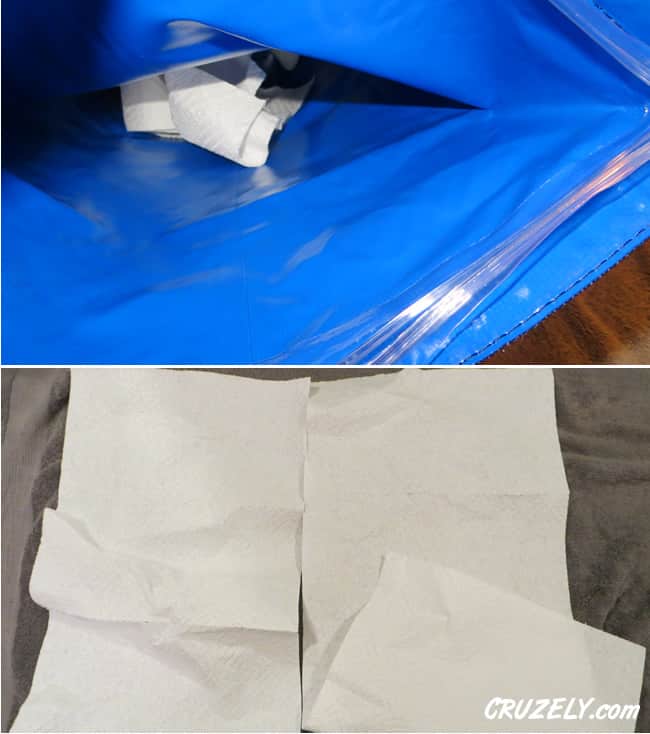
This was the only bag of the three that survived the shower test without any water entering.
Feeling confident, we actually resealed the bag with the dry paper towels. This time we ran about six inches of water into the bathtub. We then submerged the bag at different angles. If any water was going to get in, this was going to do it.
After several dunks under the water, we opened the bag up again. To our amazement, no water entered the bag, even after submerging it in the tub.
This test made the Freegrace Waterproof Dry Bag our clear winner.
Note: Some water does collect behind the zip seal on this bag, but doesn’t enter the bag. If you have something that absolutely cannot get wet, be sure to dry this area before pulling the item out of the bag.
Testing the Freegrace Waterproof Dry Bag in the Real World
It’s one thing to test a bag in a shower, but how will it perform in the real world? Before we could recommend the Freegrace bag, we took it with us on a trip to Mexico to try it out in real conditions.
We brought the bag with us to Chankanaab park in Cozumel as we went snorkeling and swimming. Inside we placed our phone, wallet, cash and other items that we didn’t want to get wet.
One thing we really like about the bag is that you can leave a little air inside of it and it floats. Not only does this make it easy to see if it gets out of reach, but you can also clip one end of the carrying strap to your swimsuit to keep the bag with you.
Just as in the shower test, we turned the bag in all directions while it floated on top of the water. Then we submerged the bag completely several times. To our amazement, there were zero leaks in the bag. All of our belongings were bone dry.
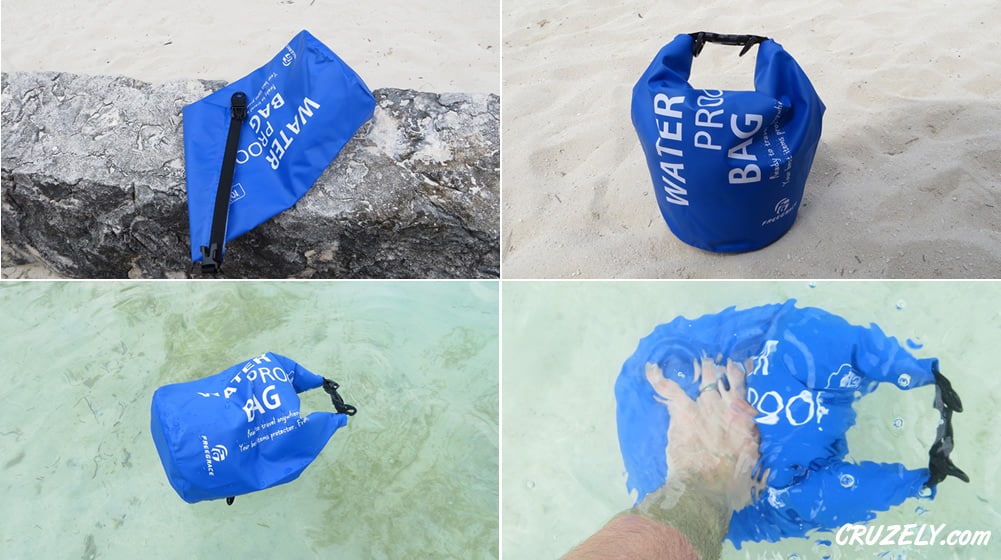
In all, the Freegrace bag took everything we could throw at it and passed with flying colors.
Summing Up the Freegrace Waterproof Dry Bag
What We Like: Bag is made of heavyweight material and seems well constructed. Includes an inner seal (unlike other bags) that seals out water, keeping your items dry. Can be submerged without leaking. We also like that the bag floats when closed.
What Can Be Improved: Water and sand can catch behind the zip seal (but not into the bag). Would like more heavy-duty hooks for the carrying strap.
Final Take: We put three different dry bags through the ringer. The Freegrace bag was the only one that didn’t allow any water inside. For under $20, it’s well worth the money in our opinion.
Note: We receive a small commission if you purchase the product through the Amazon links above. The opinions expressed are completely our own.

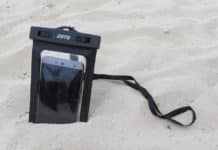





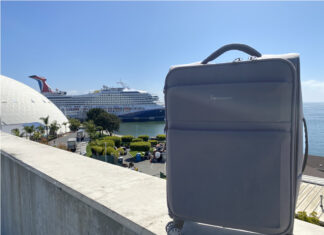
This is the most useful test and evaluation for dry bags. Great Job!!! Thanks:)
Thanks! They are a lightening deal on amazon right now for $14 something.
Let’s hope that price sticks around. As mentioned above, we paid $19.